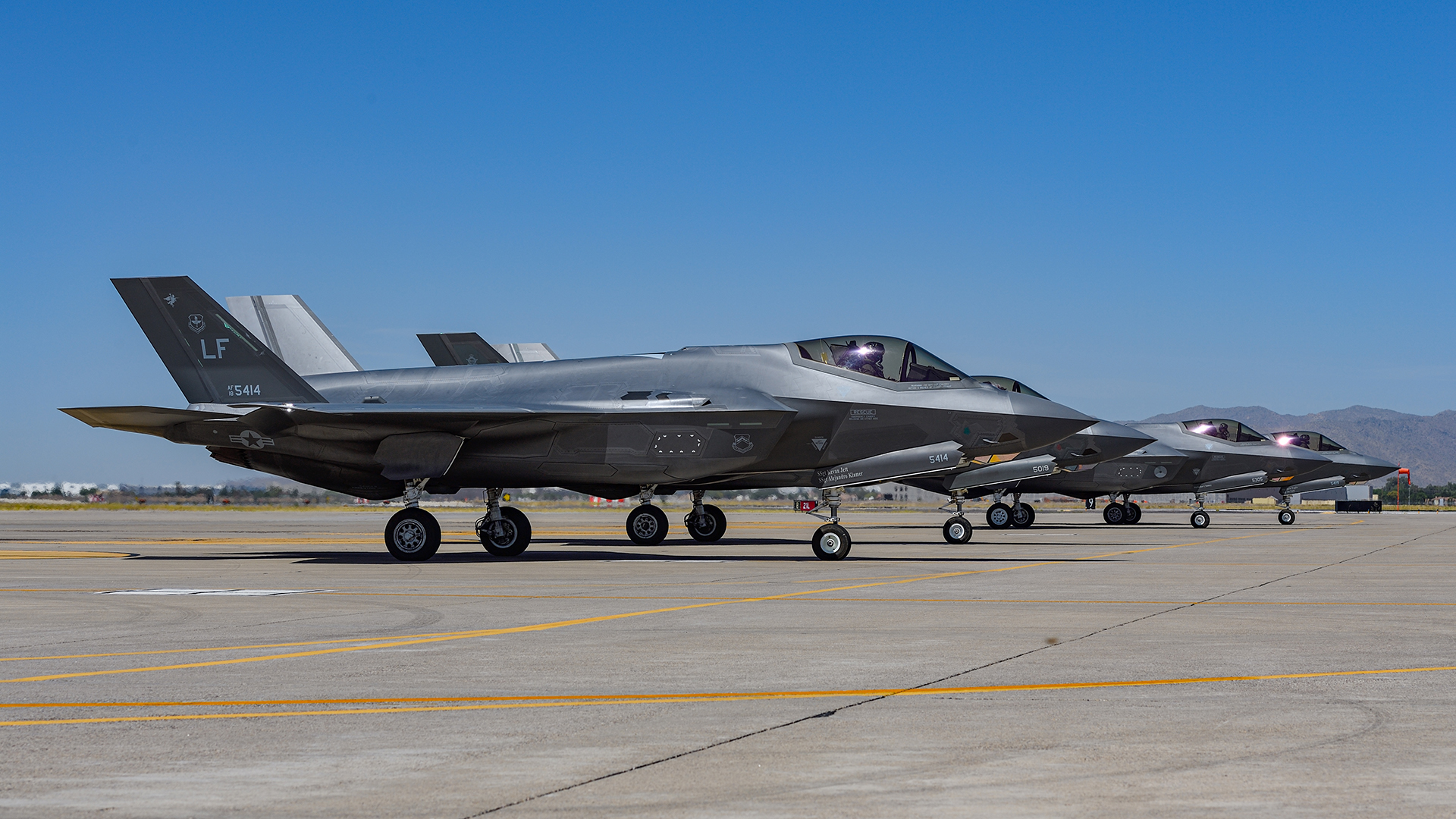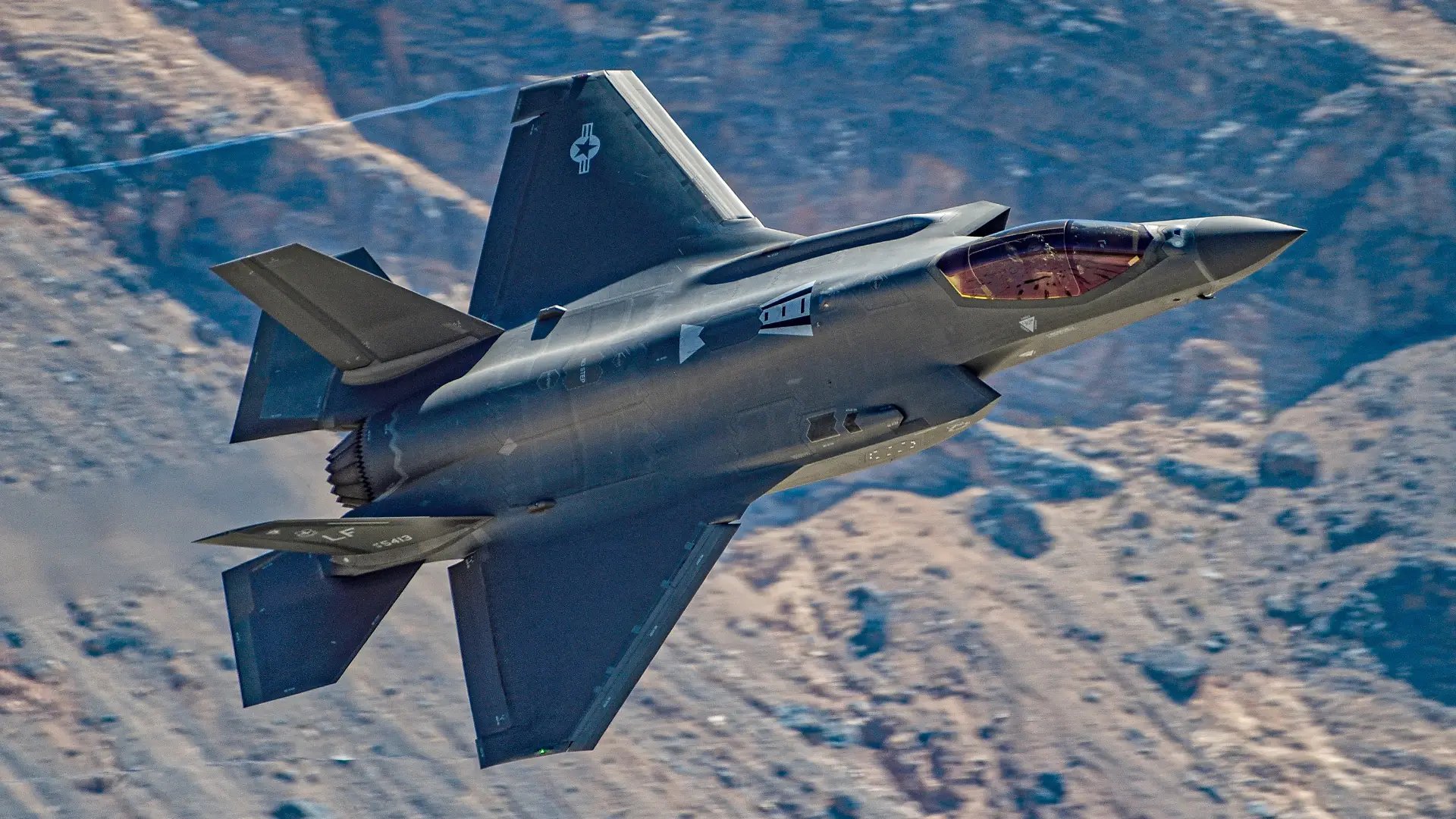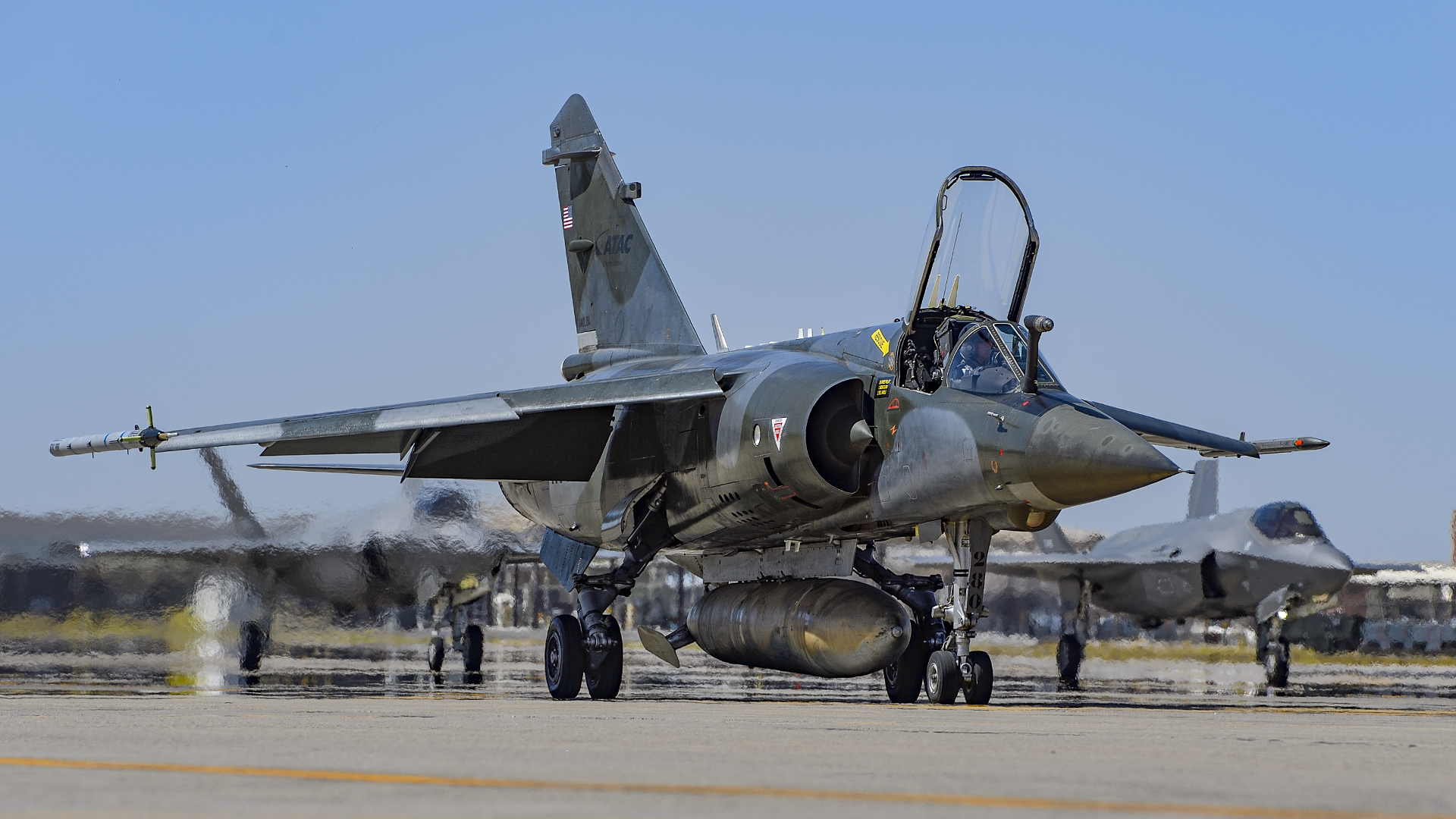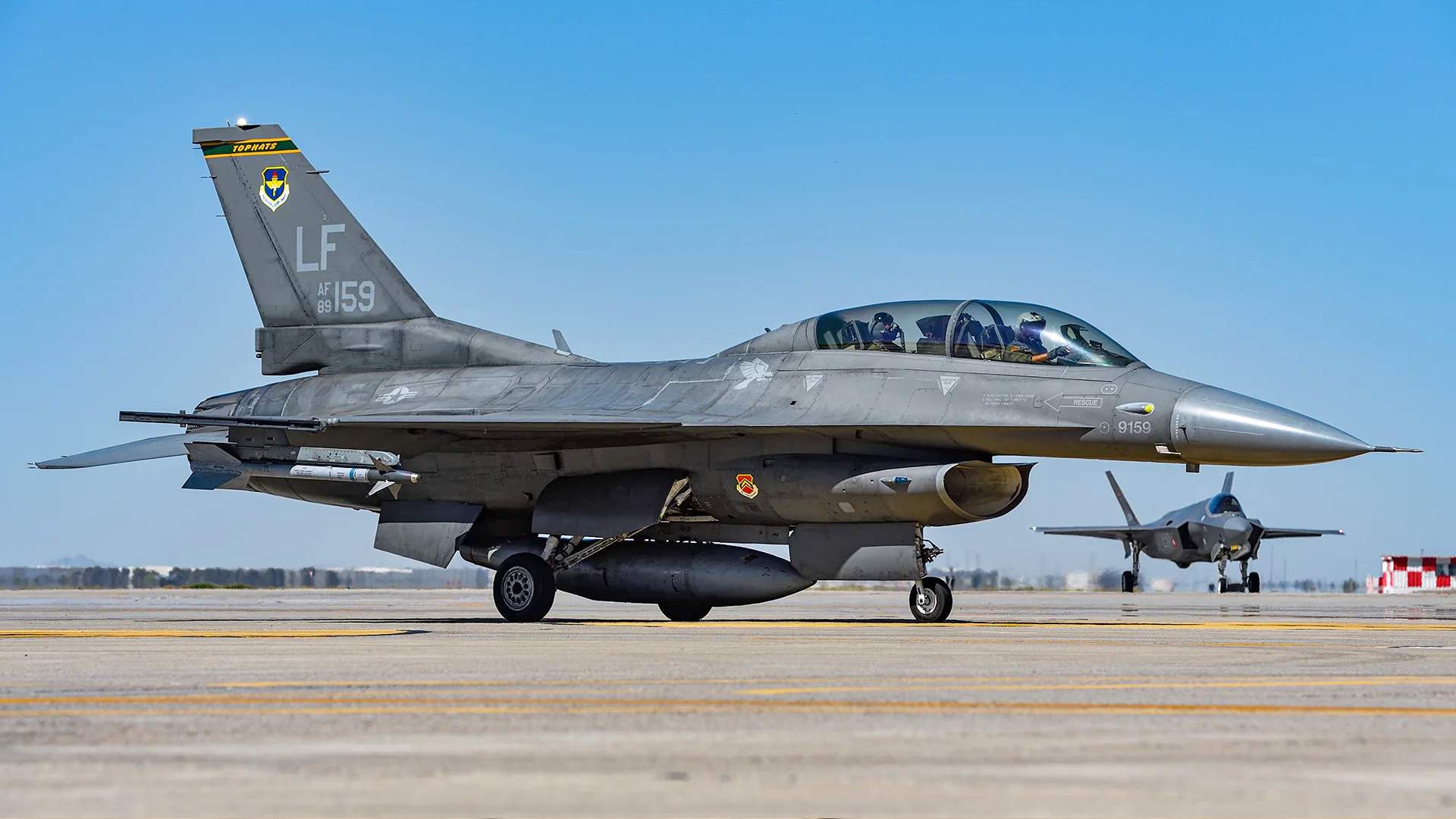A seemingly never-ending procession of F-16 and F-35 fighter jets taxi out, depart, and recover at Luke Air Force Base in Arizona each working day. The scale of the airpower training operation at this sprawling air base near Phoenix is awe-inspiring. “Luke is the largest fighter wing in the world, and it also has the largest ops wing in the world,” says Lt. Col. Jason “Trunk” Bartels, chief of integration at the resident 56th Fighter Wing.
Four F-35A and four F-16 squadrons are currently based at Luke under Air Education and Training Command (AETC), catering not only to the U.S. Air Force but also to partner-nation and Foreign Military Sales (FMS) customer pilot and maintainer training. This accounts for a mind-blowing 175 jets. The four F-35 Formal Training Units (FTUs) typically fly 20 sorties per day, so that’s at least 80 daily F-35 missions alone.

Bartels is responsible for long-term planning and wing optimization, partner nation training, and the contract Adversary Air (ADAIR) support at the base. “We have Denmark, the Netherlands, Italy, and Norway [training on the F-35 here]. Coming up, Canada would be the last [partner nation training] slated to come to Luke.” Belgium is also planning to undertake its F-35 training at Luke from 2024, but as an FMS customer rather than a partner in the core F-35 program.
“I’m confident there’s no better place in the world than Luke to train our young fighter pilots and transition our older fighter pilots [to the F-35],” says Lt. Col. Gert “Razor” van Woerden, the senior national representative for the Dutch detachment at Luke, which comes under the 308th Fighter Squadron “Emerald Knights.” The Royal Netherlands Air Force trains alongside U.S and Danish F-35 personnel in this unit. Across the flight line, the 62nd “Spike” Fighter Squadron is composed of American, Italian, and Norwegian personnel.

The first Dutch F-35s arrived at Luke in January 2019 to commence pilot training. Lt. Col. van Woerden says the initial plan was to establish a training pipeline at the Arizona base, before transferring it back home to the Netherlands. That plan has changed. “We will stay here until at least 2030, but my guess is we will stay indefinitely. There’s an enormous amount of experience here at Luke. There are about 100 F-35s here right now, and in the 308th we have 28 jets, eight of those are Dutch, four Danish, and the remainder are USAF.”

“We have access to the 12 full-mission simulators and currently around 50 percent of our pilot training is conducted in the sim. Every sortie is ‘flown’ up to three times before they fly it live in the real aircraft. The simulator will never replace the jet, and while we are doing more work in the simulator, we retain the same amount of flight hours. Right now we have five Dutch students here; two ab initio straight out of training and three crossovers from Viper. The Basic [B] Course lasts nine months and typically includes around 70 hours of flying.”

“On the squadron, we all fly each others’ jets. We all brief the same TTPs [Tactics, Techniques, Procedures], the same rules and regulations. A couple of years ago I thought we were special in having the F-35 — now everyone is buying it, and integrating is the key to success.” Comparing the F-35 to its F-16 predecessor, van Woerden says it’s like “night and day.” I just flew a two-v-six mission, two F-35s against six aggressors. I doubt they even saw us. We are executing set-ups that would have been unthinkable in the F-16,” he adds, citing the ability to combine the F-35’s low-observable design with its situational awareness.
“The F-35 is easy to fly, but its mission employment and capability are growing fast and becoming increasingly complex,” says Lt. Col. Bartels. “If you do a TI [tactical intercept] sim [session], you’re probably going to see 10-12 reps and you can put in weather, you can put in system degradation. But if you [live] fly that mission you’re only going to see three or four sets, just because you’ve got to go to-and-from the airspace, you don’t have the quick reset time [like in the sim] and your adversaries can only last so long.” Bartels says that as a rule of thumb, the students learn the basics in the simulator, and the advanced work is then honed in the air.

The increase in F-35 activity at Luke has gradually offset the long-standing F-16 monopoly at the base. The majority of USAF F-16 training has moved out to Holloman AFB, New Mexico, but currently, four Viper units remain at the Arizona base. The 309th Fighter Squadron “Wild Ducks” with aging Block 25 F-16C/Ds, and the 310th Fighter Squadron “Top Hats” with its Block 42 examples. In addition, Luke is home to a pair of FMS F-16 units supporting Singapore and Taiwan.
More changes are afoot. The 21st Fighter Squadron, a joint U.S.-Taiwan F-16 training unit, is scheduled to relocate to nearby Tucson by October. The 425th Fighter Squadron is an operational joint U.S.-Singapore unit, that will move from June 2023 to either Ebbing Air National Guard Base in Fort Smith, Arkansas, or to Selfridge Air National Guard Base in Michigan. Next summer the 310th FS will become Luke’s fifth F-35A unit, and its Block 42 F-16s will be handed over to the 309th, which will, in turn, send its old Block 25s to the boneyard and become the last and only Viper unit at Luke.

Ultimately, Luke is mandated to operate 144 F-35s in six squadrons, plus the Belgian FMS training operation. It will additionally house 26 F-16s attached to the 309th FS. The two types will continue to rub shoulders here as an essential means to assist in the streamlining of fourth- and fifth-generation fighter integration.
Despite the vastness of Arizona, the sheer weight of operations at Luke presents something of an issue when it comes to airspace. With Marine Corps Air Station Yuma to the west and both Tucson and Davis-Monthan to the east, the huge Barry M. Goldwater Range Complex, the Outlaw/Jackal and Gladden/Bagdad (GladBag) Military Operating Areas (MOAs) are in high demand.

“We are working with the Marine Corps, with Tucson, and with D-M to figure out airspace use and how we can connect it up for really long-range [work],” explains Bartels. “As it stands now we could easily send out four F-35s and eight aggressors and take up all of that airspace. So we have started to organize this airspace to manage it all together and set rules on how squadrons operate.” Even measures such as deconflicting phases of particular courses, and start dates, is making a big difference.”
It’s not just about the assigned military assets. At Luke, contract ADAIR is supplied by the Airborne Tactical Advantage Company (ATAC) under the Combat Air Forces Contracted Air Support (CAF CAS) contract supporting the F-16 and F-35 FTUs. This calls for ATAC’s Mirage F1CR/CTs to meet a mission rate of four-turn-four, meaning four jets will fly in the morning and then be “turned” for the second wave of missions. Such is the weight of requirement for contract red air at Luke that it is being expanded. In addition to ATAC, in early September Top Aces was awarded a contract to plus-up the contract aggressor force at Luke with its upgraded ex-Israeli F-16 Advanced Aggressor Fighter (AAF).

Top Aces announced on September 12, 2022, that it had been selected under the USAF CAFCAS program to provide advanced adversary air training to pilots at Eglin Air Force Base in Florida and at Luke. According to a statement from the company: “Top Aces will begin training in support of USAF F-35A and F-22 fleets next month. Valued at up to $175 million, this five-year contract will significantly enhance the training of fifth generation combat pilots.”
In the background, more significant change is afoot. To reflect the technological evolution being implemented under the USAF Pilot Training Next (PTN) effort, Lt Col Bartels and the senior planning staff at Luke are already setting the groundwork for FTU-next. This could dramatically impact the way the USAF trains its pilots for its operational squadrons. You can read more about some of these potentially revolutionary, albeit controversial changes in this past feature of ours.

FTU Next is expected to start in the 2025-26 timeframe, and its most obvious impact will be the level of simulator employment. The current dozen systems would be insufficient to support a dramatic uptick in simulator use at Luke — they are already running at 85 percent capacity — so a further 16 are planned for the base.
The F-35’s software evolution in recent years likely reflects how the mission sets it can tackle will become even more complex in the years ahead. Bartels says the USAF currently works to a ratio of 70 percent live-fly and 30 percent in the simulator. That ratio could be reversed, with the vast majority of training conducted in Luke’s simulator buildings. An increasing number of capabilities, both of the F-35 and its potential enemies, cannot be fully replicated in live-flying training, so here too, the simulator is key.
It’s a hotly contested topic, with most agreeing that increased time in the synthetic environment should not be at the cost of live flying. Bartels says “big things are coming, based on the capability of the airplane.” Luke’s resident training experts will need to factor in F-35 operating costs, along with the need for new pilots to gain sufficient exposure to complex missions, whilst also building the experience and airmanship to create the caliber of aviators the USAF demands.
Contact the editor: Tyler@thedrive.com
